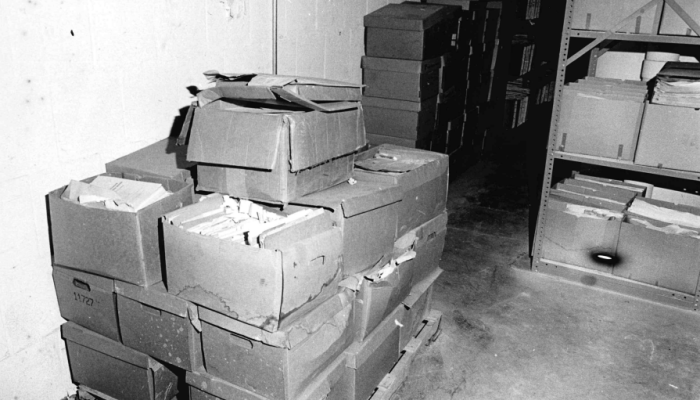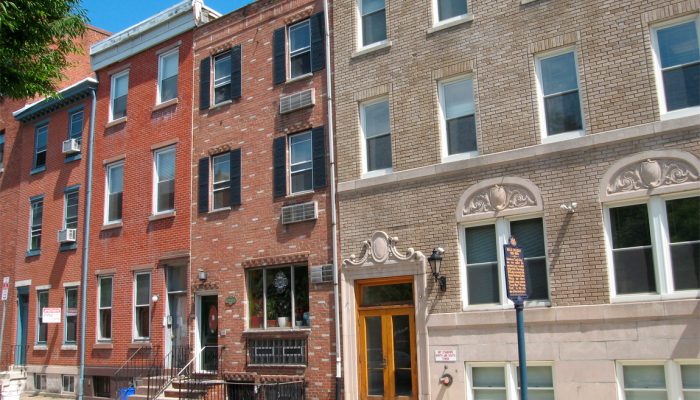In recognition of American Archives Month, the City Archives is pleased to announce a new exhibit featuring records in our holdings relating to internationally known disasters including the loss of the Lusitania and Titanic and some of their Philadelphia connections. In addition, the exhibit covers some of the steps used to protect the collection, some of the challenges we’ve faced, as well as some steps you can take to safeguard your family treasures.
Even with the implementation of industry-standard practices, red-rotting books, microfilm afflicted with vinegar syndrome, and mildewed records continue to require archival intervention. As archivists, we work to ensure the long-term stability and accessibility of Philadelphia records. We assess the environmental conditions of the spaces for which we store records, noting any major fluctuations. We process new records by re-foldering items in acid-free folders and storing them in pH-neutral boxes. We write finding aids and indexes to define the relationships between the records, the city department that generated them, and the way they were used before they were deemed “archival.” We protect the records by practicing safe-handling standards; we keep our hands clean and dry, and only use pencil when we take notes. When we pull records, we request patrons follow the same safe-handling measures.
The work archivists do is ongoing. We may re-assess the environment, re-process old records, re-inventory or update finding aids when new records are added to the collection. Other work involves being proactive about risk management. We tackle emergency preparedness by being aware of the types and volume of records in our stacks and by having a disaster plan. A disaster plan might have a different method for triage for books and paper, audio/visual material, and digital records; these items react to environmental changes and pollutants differently. Knowing the correct method for preservation for different types of materials is important for the safety of materials after a disaster. Various objects, which can be utilized in disaster recovery, are on display, too. It is best to have recovery tools like masks, gloves, sponges, mops, buckets, plastic sheeting, flashlights, and anything else normally used in disaster response, easily accessible.
City Archives preserves the history of Philadelphia’s city government, but it is not the only place where records are preserved. Your own records, your family records, and even those records which you have deemed historically significant, all the records which you store in your home, make up the history of Philadelphia. Some simple solutions may help you preserve your records. Do not store materials in attics or basements, as these are spaces where major fluctuations in temperature and humidity occur. Do store records in a closet in a main floor closet; this will keep your records out of the sunlight as well. Be careful about storing records in plastic tubs or sealed, plastic bags. If any mold/mildew/liquid persist in these spaces, all records within the tub or bag may be compromised. It is a good idea to assess changes in humidity for the spaces in which you store records. Digitization can be an option to preserve audio/visual materials, but keep in mind that digitization is not just duplication. It is an ongoing process, which requires assessing records and ensuring you have at least two copies of records, one of which should be stored offsite. The Library of Congress recommends “[having] a ‘3-2-1’ rule: make three copies, store two on different types of media and one in a different location,” which may also be helpful. Make sure you have an inventory of the types of records you have and the locations in which they are stored.
Some of Philadelphia’s Connections to Disasters
City Archives has records from a number of well-known disasters for the past two centuries. A death certificate and deposition document the loss of William Hodges, who perished onboard the ocean liner Lusitania. The Lusitania was torpedoed off the coast of Ireland early in World War I. A native to Philadelphia, Hodges was buried in Monument Cemetery in 1915. According to the deposition, an error in the retrieval of the bodies led to the misidentification of Hodges as his younger brother.
A death certificate and a passage in a City Council Journal document the loss of John and Anna Lichtenberg, who were lost in the Johnstown flood in 1889. In response, City Council gave fire engines and other equipment to the citizens of Johnstown to aid in recovery efforts.
A City Council Journal and two letters to the former Mayor Dilworth document Richardson and Ann Dilworth’s experience with the Andrea Doria, which sank in 1956, but not before the majority of the passengers were saved. Members of City Council expressed gratitude in their journal. So, too, did members of the public, as many of them wrote letters to express admiration for the Dilworths’ efforts while onboard.
Pictures and several building permits document the history of the former Broad Street Station and the efforts made to improve the station after two fires devastated the station in the 1920s and 1940s. Today, Penn Center sits on the footprint of the Broad Street Station.
Although more than 110 years have passed since the sinking of the Titanic on its maiden voyage in 1912, interest in the disaster endures thanks to hundreds of books, a number of movies, and the discovery of the wreck in 1985. The City Archives has a number of materials associated with Philadelphians who embarked for the United States on the doomed liner. Featured prominently in the exhibit is the Dulles family. William Crothers Dulles was lost in the epic disaster; his death record is the only known record of its kind in the Archives as his body was identified and brought back to the city for burial. Other local people were lost (including members of the Thayer and Weidner family also featured in the exhibit) but their remains were not brought back for burial, if found at all. Also exhibited with William’s death record are deed and marriage records from the Dulles family and a City Council resolution commemorating those lost.




